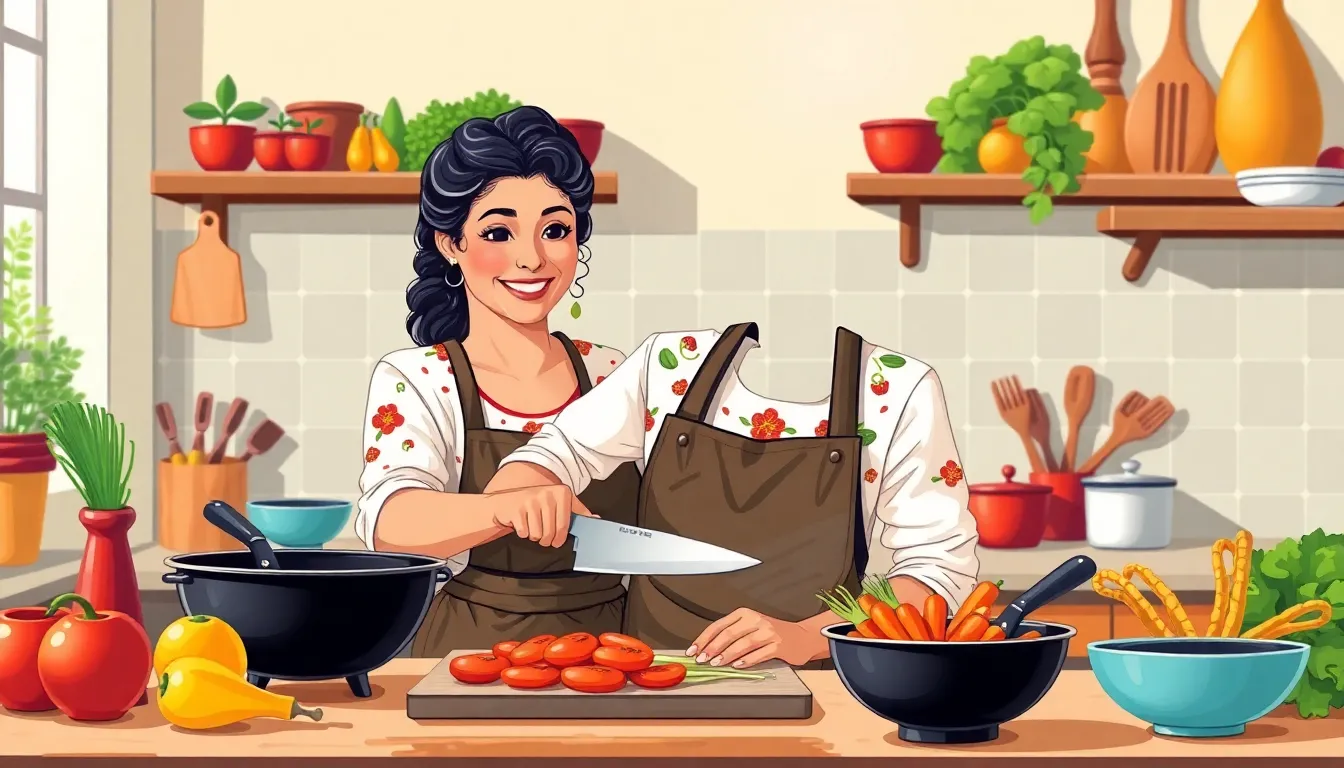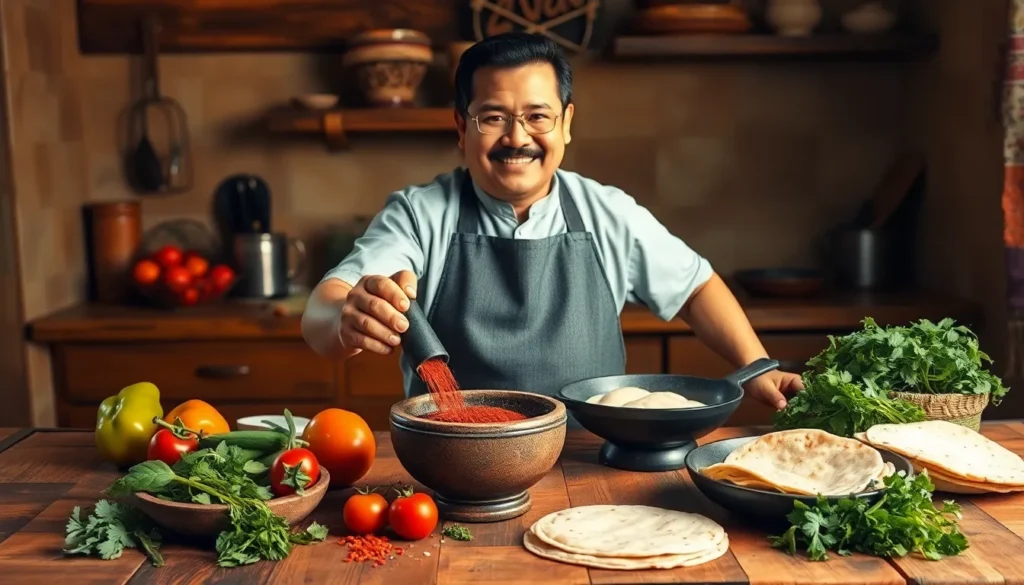When it comes to Mexican cooking, it’s not just about throwing together some beans and tortillas and calling it a day. Oh no, it’s an art form that’s been perfected over centuries, blending tradition with a dash of innovation. From the sizzling sounds of a comal to the smoky aroma of a molcajete, these techniques are the secret ingredients that elevate a simple meal into a fiesta for the senses.
Table of Contents
ToggleOverview Of Mexican Cooking Techniques
Mexican cooking techniques reflect a rich tapestry of history and culture. Traditional methods enhance flavors and textures, creating a vibrant culinary experience. Using a comal, for instance, allows for the even cooking of tortillas and an array of salsas. Another essential tool, the molcajete, serves for grinding spices and herbs, releasing essential oils that intensify dishes.
Slow cooking methods, such as stewing, highlight the depth of flavors in recipes like birria and pozole. Braising, common in various regions, tenderizes meats while infusing them with aromatic spices. These techniques emphasize patience and attention, leading to satisfying meals.
Grilling also plays a significant role in Mexican cuisine. Grilling meats over open flames adds a smoky flavor, enhancing the overall dish. Firing up a traditional asado showcases not only skill but also a communal aspect, as families gather to enjoy food together.
Further, steaming ingredients using a basket or tamalera preserves nutrients and traditional flavors. Incorporating ingredients like masa into tamales displays the creativity inherent in this cooking style. Baking, particularly in clay ovens, infuses breads and pastries with unique textures and flavors.
Each technique connects to regional variations. Techniques vary by state, reflecting local traditions and available ingredients. Mastery of these techniques transforms cooking into an artistic expression, showcasing the diverse elements that define Mexican culinary arts.
Essential Tools For Mexican Cooking

Essential tools enhance the efficiency and authenticity of Mexican cooking. Key items include knives and various cooking utensils.
Knife Skills
Mastering knife skills is vital in Mexican cuisine. Different knives serve specific purposes, from chopping vegetables to filleting fish. A chef’s knife excels at dicing onions and slicing meat. Paring knives efficiently peel garlic and other small items. Investing time in learning proper techniques ensures precise cuts, influencing cooking times and textures. Many cooks recommend practicing skills with a variety of ingredients to build confidence and speed. Various chopping techniques, including the rocking and the claw grip, promote safety while improving efficiency.
Cooking Utensils
Key cooking utensils elevate the quality of dishes. A comal, a flat griddle, excels at cooking tortillas and toasting spices. Tongs help manage meats on the grill, ensuring even cooking. A sturdy wooden spoon mixes ingredients while preventing damage to pots. Measuring cups and spoons provide accuracy in recipes, which is crucial for achieving authentic flavors. Asada grills create deliciously smoky flavors, while a molcajete is perfect for grinding herbs and making salsas. Investing in high-quality utensils contributes to successful meal preparation, enhancing both flavor and presentation.
Traditional Cooking Methods
Mexican cuisine incorporates various traditional cooking methods that contribute to its unique flavors and culinary identity.
Grilling (Asar)
Grilling holds a special place in Mexican cooking. Barbecued meats acquire a distinctive smoky flavor during asados, a traditional social gathering. Various options exist for grilling, including carne asada and chicken, which are seasoned with spices or marinades prior to cooking. Recipes often emphasize techniques like keeping the grill at a consistent temperature for optimal results. Grill marks not only enhance presentation but also add a desirable char. Asar allows for a communal experience, encouraging sharing among family and friends while enjoying deliciously grilled foods.
Steaming (Cocer al Vapor)
Steaming maintains the vibrant colors and nutrients of vegetables in Mexican dishes. Techniques involved in cocer al vapor help retain essential vitamins, enhancing overall health benefits. Staples like tamales and vegetables are often processed through steaming, providing moist textures and rich flavors. Various steaming methods can be employed using simple tools like a steamer basket or a traditional olla de vapor. This technique creates a delicate taste profile, allowing ingredients to shine individually while harmonizing as part of a larger dish.
Frying (Freír)
Frying plays a crucial role in achieving crispy textures and bold flavors in many Mexican recipes. The process enhances foods like tacos dorados and quesadillas, where a perfect golden-brown finish is desired. Utilizing the correct oil temperature significantly affects the final outcome. Instant gratification comes from frying food quickly, locking in moisture while creating delectable, crunchy exteriors. Essential utensils like skillets or deep fryers streamline the frying process, ensuring consistency. Options for frying range from light sautéing to deep frying, each contributing uniquely to the overall sensory experience in Mexican cuisine.
Contemporary Techniques In Mexican Cooking
Contemporary Mexican cooking employs innovative techniques that enhance flavor and presentation. Two prominent methods include sous vide and molecular gastronomy, which redefine traditional practices.
Sous Vide
Sous vide involves cooking food slowly in a vacuum-sealed bag submerged in water at a controlled temperature. This technique ensures even cooking, preserving moisture and flavor, which is crucial for meats commonly used in Mexican dishes. Chefs use sous vide for carne asada, achieving a tender and juicy texture that ordinary cooking methods might overlook. Precise temperature control allows for consistent results, making complex recipes more accessible. Techniques like finishing the meat on a hot grill create a charred exterior that complements its succulence.
Molecular Gastronomy
Molecular gastronomy revolutionizes how ingredients interact in Mexican cuisine. Chefs use scientific methods to manipulate texture and flavor. Techniques like spherification create unique presentations, such as tomato caviar that bursts with flavor. Foams enhance traditional dishes, adding unexpected lightness and new sensory experiences. Ingredients like agar and lecithin play a significant role in transforming classic recipes into innovative culinary delights. This approach enables a deeper exploration of flavor combinations, marrying tradition with modern artistry.
Regional Variations In Cooking Techniques
Mexican cooking techniques vary significantly across regions, each reflecting local ingredients and cultural traditions.
Northern Mexican Techniques
Northern Mexico emphasizes grilling over open flames. Asar, or grilling, forms the basis for many traditional dishes, such as carne asada and cabrito. This method imparts a distinct smoky flavor while fostering community through shared meals. Additionally, the use of cast iron skillets is common, enhancing heat retention for perfect searing. Stewing is also popular in this region, with dishes like birria showcasing rich flavors developed through slow cooking. Utilizing local ingredients, such as beef and wheat, showcases the agricultural bounty of northern states.
Southern Mexican Techniques
In Southern Mexico, steaming takes center stage. Techniques like cocer al vapor preserve the vibrant colors and nutrients in vegetables, enhancing health benefits while delivering moist textures in dishes like tamales. Use of spices and herbs thrives in this region, as techniques like grinding in a molcajete deepen flavors and elevate dishes. Traditional moles, rich with complex layers of taste, famously highlight this technique. Furthermore, frying is significant, resulting in crispy tacos dorados and quesadillas that delight the senses. Emphasis on fresh ingredients, such as corn and fresh herbs, strengthens the authenticity of southern culinary arts.
Mexican cooking techniques embody a rich cultural heritage that transforms meals into vibrant celebrations. Each method from grilling to steaming showcases the unique flavors and textures that define this cuisine. Mastering these techniques not only enhances the authenticity of dishes but also elevates the cooking experience into an art form.
Investing in essential tools and understanding regional variations further enriches one’s culinary journey. By embracing both traditional and contemporary methods, cooks can explore the depths of flavor and creativity that Mexican cuisine has to offer. This culinary adventure invites everyone to appreciate the artistry behind each dish, making every meal a delightful experience.





